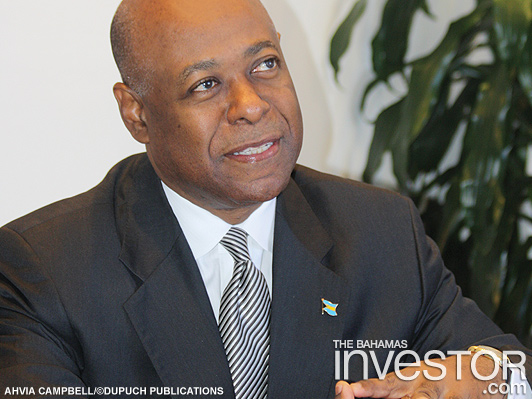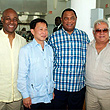| Published: Date: Updated: Author: |
The Bahamas Investor Magazine January 21, 2014 January 21, 2014 Tameka Lundy |
Five hundred thousand new visitors to The Bahamas; flourishing niche markets, such as sports and religious tourism; and buoyant airlift provided by both legacy and charter air carriers, linking new markets in Africa, Europe and Asia to The Bahamas. These are among the goals set by The Bahamas’ Ministry of Tourism to grow the industry that has become the linchpin of The Bahamas’ economy. In an exclusive interview with The Bahamas Investor, Minister of Tourism Obie Wilchcombe shared details of a multi-faceted blueprint to revolutionize how The Bahamas is marketed globally and enhances its resilience.
Q: You have said that The Bahamas is a supreme international brand. What is the business plan to ensure the economic sustainability and viability of tourism for the future?
A: We now have the Internet and it is a tool for marketing. You can reach the world now, real time, simultaneously. I couldn’t do that before. If I ran an ad in Florida, or [anywhere in] the US, it was not going to be seen in Europe or Asia. But if I am online, I can be seen around the world at the same time. So, we are going to be using the digital platform very effectively. The Ministry of Tourism will also introduce the first Internet TV channel, so that 24-hours a day you can get information about The Bahamas. That is what people want to know. The message will be focused on this high quality brand; a brand that we will continue to present to the world; and it will be a premium brand, a brand of absolute excellence.
Q: Recently the NBA’s Miami Heat held its training camp in The Bahamas and the Pure Silk LPGA Golf Classic will be returning this month. What is the plan to generate more momentum in niche markets, such as sports tourism?
A: This year we will have a whole schedule that includes golf, beach volleyball, and for the first time, American football. We are going to have a schedule of events that nobody has ever seen before, every other month. Take religious tourism, there are activities going on all the time and there is a significant amount of money spent on religious tourism. We are looking at the entire calendar year. Apart from leisure tourism, we are going to ensure that we are always filling the gaps with [customers from] niche markets. We have somebody assigned to promote to colleges in the US and we see that the numbers have already grown for the bookings from next month and onward. We are going to target family reunions, the Servicemen of America, all intended to ensure that we have no periods during the year where we have down time. We are going after specific markets and groups in particular. Groups are going to drive a lot of business back to The Bahamas. We want to ensure that we have the islands filled with visitors, always coming for some reason.
Q: The Baha Mar megaresort is under construction on Cable Beach on New Providence and a new hotel owned by the Sunwing Group is opening on Grand Bahama. How are you strategically preparing to increase airlift to fill expanding room inventory throughout The Bahamas?
A: We are looking, in the first instance, at about 500,000 new visitors per year. We need to grow the industry, and, for that to work, we have to go after new markets, find the areas, find the people and get them to The Bahamas. We have to strengthen our relationship with the legacy carriers and the low-fare carriers. Getting Bahamasair back into the mix is going to be critical; getting it back into [flying from] New York, back into New Jersey, back into Washington, DC, back into Philadelphia. We have to make sure that people always have a way to get to The Bahamas–either direct to the Family Islands or to come through the new airport in Nassau, which allows for that connectivity. So, the strategy is to go after more business and also to go after charters. Right now, we are talking to groups from Russia, Latin America and Africa, which all intend to introduce charter services.
Q: What are the top priorities for the Ministry of Tourism to develop the tourism product in Grand Bahama?
A: The first is inventory: getting more rooms. Grand Bahama has less than 2,000 hotel rooms. The second is airlift. Right now, the national flag carrier doesn’t even fly from Miami to Freeport. American Airlines does, off and on, but we don’t have sustained business. We also need more cruise [lines]. We also want more ferry services; a real ferry service that will bring 200-400 people per day, who can overnight if they wish. Those are the three areas we are working on in terms of business. From the human development side, we have to get our people ready. Moreover, we are going to make Grand Bahama the media platform for the Ministry of Tourism. We will also put our social networking [hub] in Grand Bahama. So, Grand Bahama is going to play a major role in where we go from here.
Q: The Ministry of Tourism launched the “Behold” marketing campaign in early 2013. What has been the impact of that campaign?
A: It was intended to get us back into the marketplace and I also wanted people to behold the beauty of The Bahamas. We have had limited print and TV ads, so Behold was a way to get us back out there. Now, we are going to start a sustained radio campaign that will have us on the air, hopefully, all year and keep us in the face of the consumer.
Q: Historically, the lion’s share of ownership in tourism has been with foreign direct investment. What efforts are being made to create a level playing field to facilitate Bahamian ownership and entrepreneurship?
A: One of the great moments for me as the Minister of Tourism was recently when a Bahamian started a major boutique hotel. I felt very good about that, because I thought it was making the right statement. You always hear about Bahamians getting involved in some aspect of the industry, but not taking their money and investing in a major hotel. For the boutique hotel in Lyford Cay, Mark Holowesko is spending $20-$30 million. I think that is significant. The Symonettes are now doing something in Eleuthera and that is significant. This is our country. These are the assets God gave us. Bahamians have to have more pride and determination and make things happen. We want to get more Bahamians involved in ownership, but we have to have the courage to do so.
Q: Currently, tourism is the single largest contributor to the gross domestic product of The Bahamas. What do you envision as its potential to generate further economic stability and growth?
A: The Bahamas has to become number one in the industry again. We have to ensure that whatever sector it is, whether it’s weddings, or religious or leisure tourism or group visits, we have to use tourism as a platform for greater diversity in the sector. Linkages have to happen. Then, of course, we need more Bahamian professionals in the industry. We have to push to ensure that more Bahamians get involved in the ownership of the industry. You have to appreciate that Bahamians must have a vested interest in what we do and we have to find ways to do it. We have to cause this dynamism to be redeveloped.










